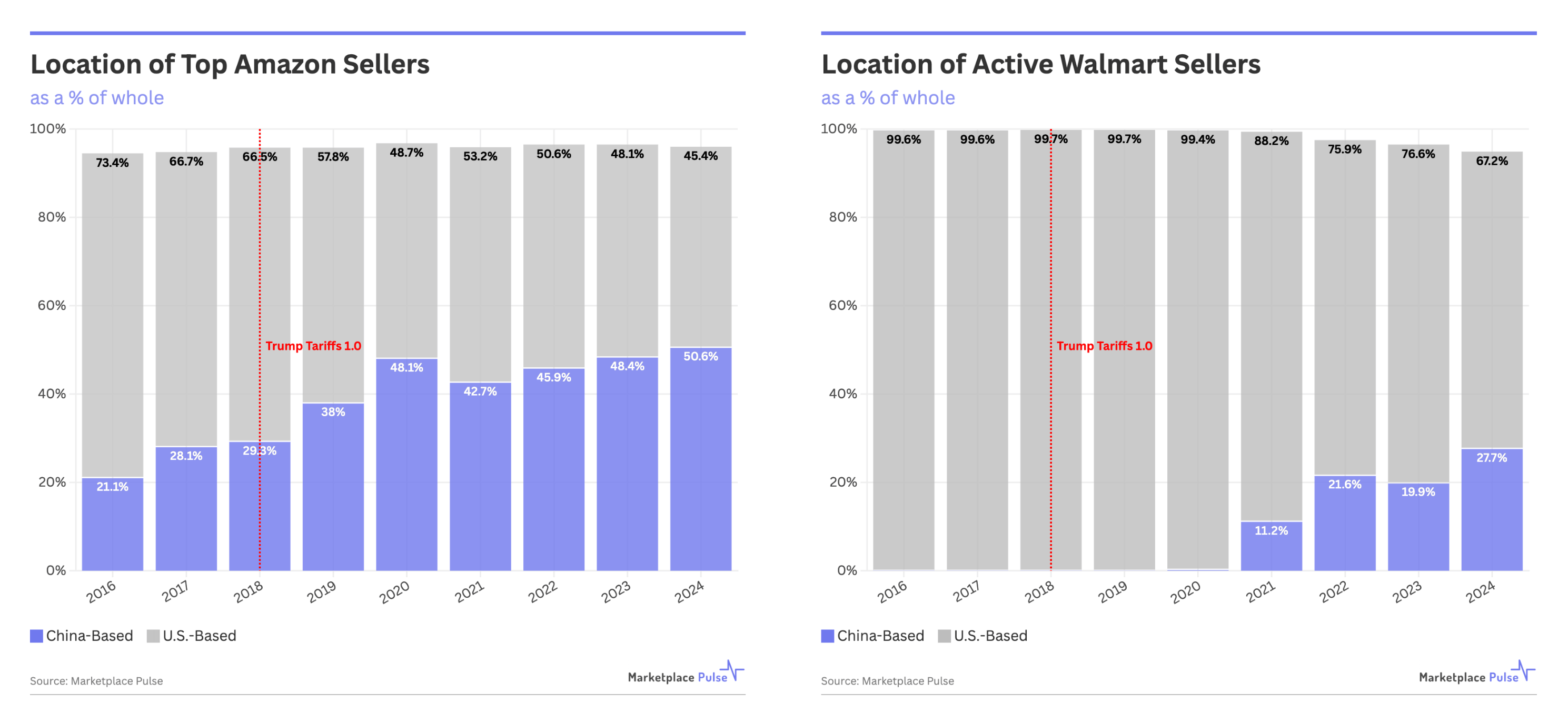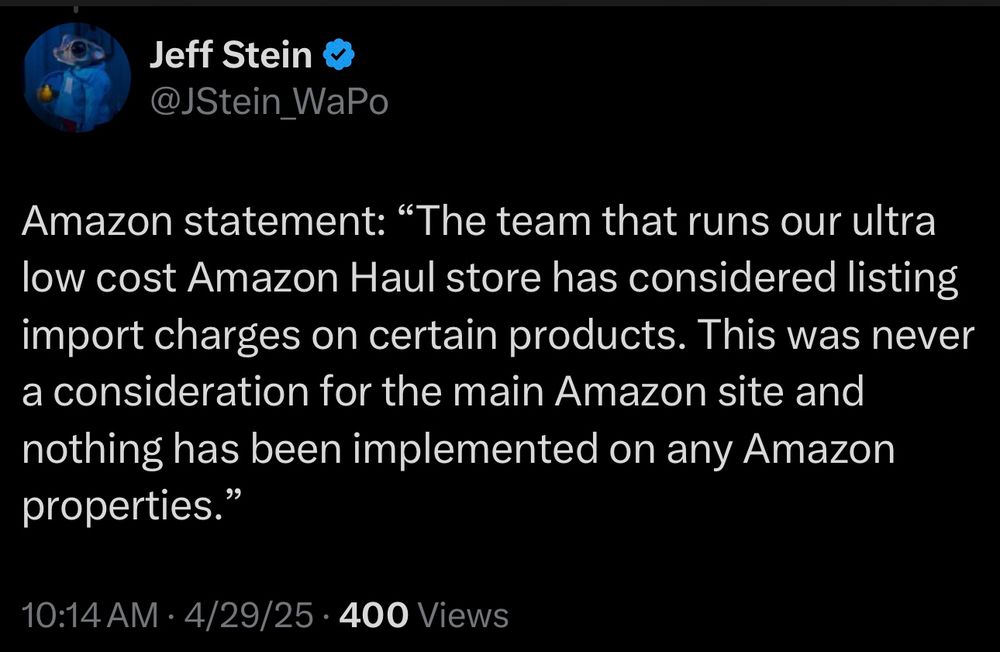Tariff Notations on Imported Products
I just heard during a white house briefing that Amazon announced it will put a notation on the order(s) during check-out to buyers highlighting how much the prices have been raised by the Trump tariffs... (Punchbowl News is the source).
Can't find any details online but I'm wondering how it's going to affect my existing inventory if at all because no tariffs were applied to what I have in the house now.
I wonder if they're just planning to flag all products that were listed as imported from China during listing creation and adding $145%...I wonder if sellers will be made aware of which products will display such a message to buyers...
This would be a good thing for us sellers as we are not getting same breaks as GM, Ford, Walmart, Apple, Trump Bibles, etc., are getting via exemptions...
Tariff Notations on Imported Products
I just heard during a white house briefing that Amazon announced it will put a notation on the order(s) during check-out to buyers highlighting how much the prices have been raised by the Trump tariffs... (Punchbowl News is the source).
Can't find any details online but I'm wondering how it's going to affect my existing inventory if at all because no tariffs were applied to what I have in the house now.
I wonder if they're just planning to flag all products that were listed as imported from China during listing creation and adding $145%...I wonder if sellers will be made aware of which products will display such a message to buyers...
This would be a good thing for us sellers as we are not getting same breaks as GM, Ford, Walmart, Apple, Trump Bibles, etc., are getting via exemptions...
15 replies
Seller_roNdLQpqbVoOH
I didn't hear that, but I did see a piece on the news about Temu and Shein adding the (heavy) extra tariff fees during the checkout process.
But, the story noted, these items - upcharges included - are still going to be cheaper than their counterparts made in the USA.
So much fallout yet to happen.
I hope you get answers from Amazon, but, as you know, that's unlikely.
Seller_Ggt6s7zXEwLbA
White House is clobbering Amazon over the issue. Maybe it's time for Amazon to put an American flag on products with (1) American seller and (2) No tariffs meaning it is US made.
Practically, I'm not sure how Amazon would know what products have a tariff and how much unless this is only for Amazon's own products.
Seller_xo4Akj7FBBnfC
That Punchbowl News report (excerpted below) is now making headlines across major news outlets.
The White House has fired back, calling Amazon’s move a "hostile and political act."
Punchbowl News excerpt:
Amazon doesn’t want to shoulder the blame for the cost of President Donald Trump’s trade war.
So the e-commerce giant will soon show how much Trump’s tariffs are adding to the price of each product, according to a person familiar with the plan.
The shopping site will display how much of an item’s cost is derived from tariffs – right next to the product’s total listed price.
Seller_5ttu1AKpRj26d
American sellers have dropped below 50% nearly two years ago. However, Chinese sellers have grown above 50% only recently, as there is a small percentage of sellers in other countries. Based on Marketplace Pulse research, Chinese sellers now represent more than 50% of the top sellers on Amazon.com, with U.S. sellers representing roughly 45% and the rest in the U.K., Canada, or other countries. China’s share of all active sellers is even higher. (Some international sellers incorporate in the U.S., so American sellers’ actual share is lower than 45%)
Amazon acknowledged the Chinese seller market share on its marketplace for the first time in the annual Form 10-K filing with the SEC in February 2024, calling it “significant.” However, it was significant years before Amazon called it out — their share has steadily increased for nearly a decade on Amazon.com in the U.S. and its other worldwide marketplaces.

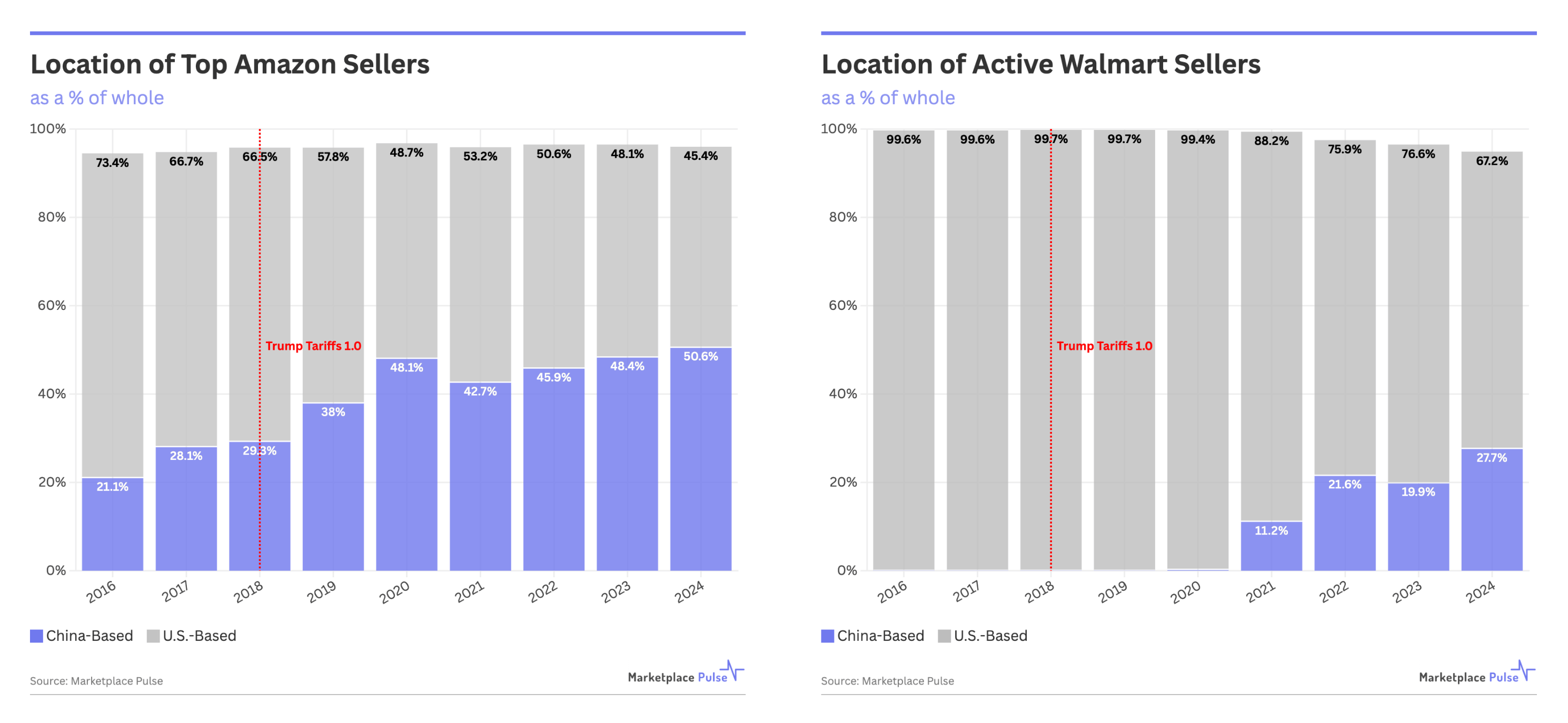
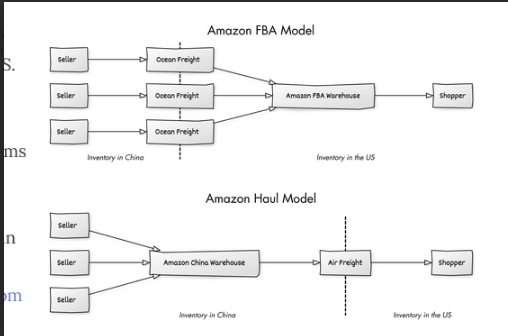
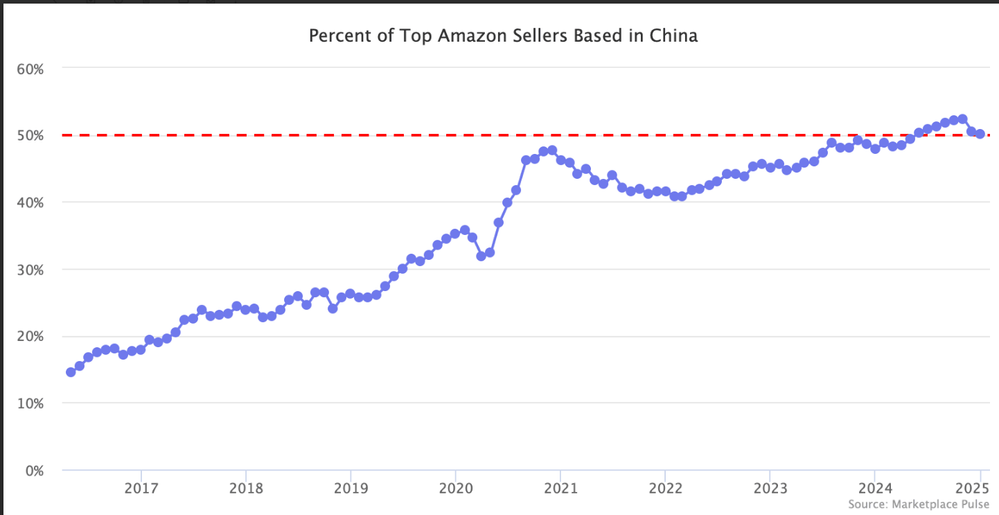
Seller_5ttu1AKpRj26d
April 17, 2025
Trump's Tariffs Won't Save American E-commerce
Aggressive China-specific tariffs announced and rapidly escalated by the Trump administration will not reverse the fundamental dynamics that have led Chinese sellers to dominate U.S. e-commerce marketplaces. Despite promises that tariffs will help American businesses, historical evidence shows they simply make products more expensive for American consumers while failing to shift market share to domestic sellers.
Chinese sellers have steadily increased their presence on major U.S. marketplaces regardless of tariff policies. Today, more than 50% of top sellers on Amazon’s marketplace are based in China, up from less than 40% five years ago. On Walmart’s marketplace, Chinese sellers now represent 28% of all active sellers, up from less than 1% at the start of 2021.
Rather than bringing manufacturing back to America, the 2018 tariffs simply redirected trade flows. The study found that approximately $165 billion in trade per year was rerouted as companies built complex workarounds, including shipping through third countries, restructuring corporate entities, and adjusting product classifications to avoid tariffs. These supply chains were reconfigured rather than repatriated while the underlying marketplace dynamics continued to evolve in favor of Chinese sellers.
This evolution has been further accelerated by Amazon’s training of shoppers to look past brand names, with e-commerce becoming increasingly “brandless”. This marketplace reality favors sellers with the most efficient supply chains and lowest overhead, areas where Chinese sellers maintain significant advantages regardless of tariff levels.
Chinese sellers have structural advantages that tariffs cannot address. Many are either manufacturers themselves or have a closer proximity to manufacturing than American businesses. They benefit from Chinese government support through export subsidies and tax rebates. And they’ve become increasingly sophisticated in marketplace operations through years of platform experience.
While tariff advocates cite short-term pain for long-term gain, diverting even a small percentage of Chinese manufacturing back to the U.S. would take years. However, the impact on American e-commerce businesses is both immediate and potentially devastating.
Recent analysis from e-commerce software provider Threecolts reveals that small brands and private label businesses are facing a severe cash crunch, with many unable to afford the unexpected tariff costs for inventory already in transit.
Unprecedented tariff rates are forcing domestic e-commerce businesses into impossible choices: scrambling for emergency capital at predatory interest rates, abandoning shipments they can’t afford to clear, or attempting to raise prices in an already price-sensitive market. Without imminent policy changes, many face the threat of bankruptcy. Ironically, these are the very businesses these tariffs were ostensibly designed to protect.
The data points to a familiar outcome: higher prices for American consumers, complex supply chain disruptions, bankruptcies among domestic sellers, and minimal impact on the marketplace dynamics that have led to Chinese seller dominance. Tariffs won’t save the American share of e-commerce and may well accelerate its decline
Seller_Ggt6s7zXEwLbA
To be fully transparent Amazon should show how much of the product price it receives.
Seller_kH241gMnkEuoL
Hello. I totally understand your concerns about how this might impact our products. Personally, I’ve started using a bonded warehouse in LA to help manage these uncertainties.
It’s been really beneficial—tariffs are deferred while things settle, and I’ve been able to export to Canada without paying extra U.S. fees.
[Moderator Edit: Removed Personal Information]
Seller_5ttu1AKpRj26d
A REAL WIN FOR ALL USA 3RD PARTY SELLERS ON AMAZON WILL COMPETE VS THE CHINA SELLERS
American sellers have dropped below 50% nearly two years ago. However, Chinese sellers have grown above 50% only recently, as there is a small percentage of sellers in other countries. Based on Marketplace Pulse research, Chinese sellers now represent more than 50% of the top sellers on Amazon.com, with U.S. sellers representing roughly 45% and the rest in the U.K., Canada, or other countries. China’s share of all active sellers is even higher. (Some international sellers incorporate in the U.S., so American sellers’ actual share is lower than 45%)
Amazon acknowledged the Chinese seller market share on its marketplace for the first time in the annual Form 10-K filing with the SEC in February 2024, calling it “significant.” However, it was significant years before Amazon called it out — their share has steadily increased for nearly a decade on Amazon.com in the U.S. and its other worldwide marketplaces.
